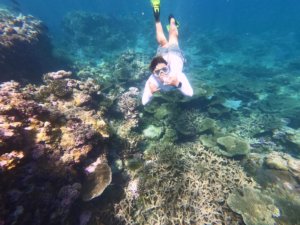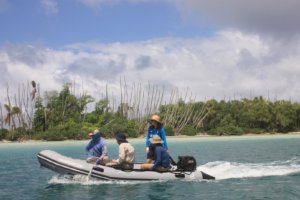We have just returned from one of the most beautiful places on Earth – Palmyra Atoll. Palmyra, a series of coral islands in the middle of the Pacific that most people have probably never heard of, represents hope for healing.
The atoll, located approximately 950 nm south of Oahu, has truly felt the impact of man’s influence. During World War Two, it was strategically located, so the U.S military built air strips on Cooper Island and blasted a deep water channel through the coral reef. After the war was won, the island lost its strategic importance and was abandoned. Entrepreneurs saw an opportunity and planted coconut plantations. The plantations went bust and were abandoned. The atoll was left in a sorry state – invasive plants taking over the land, rats ravaging the eggs of the native birds, and a dying coral reef.

Then man intervened again. In 2000, Palmyra Atoll was purchased by The Nature Conservancy who partnered with the US Department of Fish and Wildlife to have it declared a National Wildlife Refuge. In their effort to restore the ravaged landscape, TNC first tackled removing the invasive rat population. With the removal of the rats, more of the native birds were able to survive until adolescence. Then they took on removal of the non-native coconut trees. With machete, herbicide, and a lot of sweat, the invasive trees are being removed, and the native trees and shrubs are returning to prominence. The red footed boobies and the frigate bird populations have returned to nest in the native vegetation. The atoll now boasts one of the largest concentrations of red footed boobies on the planet.

The thriving bird population’s contribution of guano has improved the health of the coral. As the health of the coral reef returned, more fish sought refuge and sustenance in the reef. Our crew from Sea Dragon were the first non-scientists to be allowed to visit Palmyra in 2022. While on anchor at Palmyra, we were able to dive six sites. I have never seen a greater variety or abundance of coral. It is no exaggeration to say that this is one of the premier dive sites in the world.
The islands and coral are returning to health. The bird, crab, and fish populations are thriving. On one of the most remote locations in the Pacific hope for healing is alive.
Scott





















